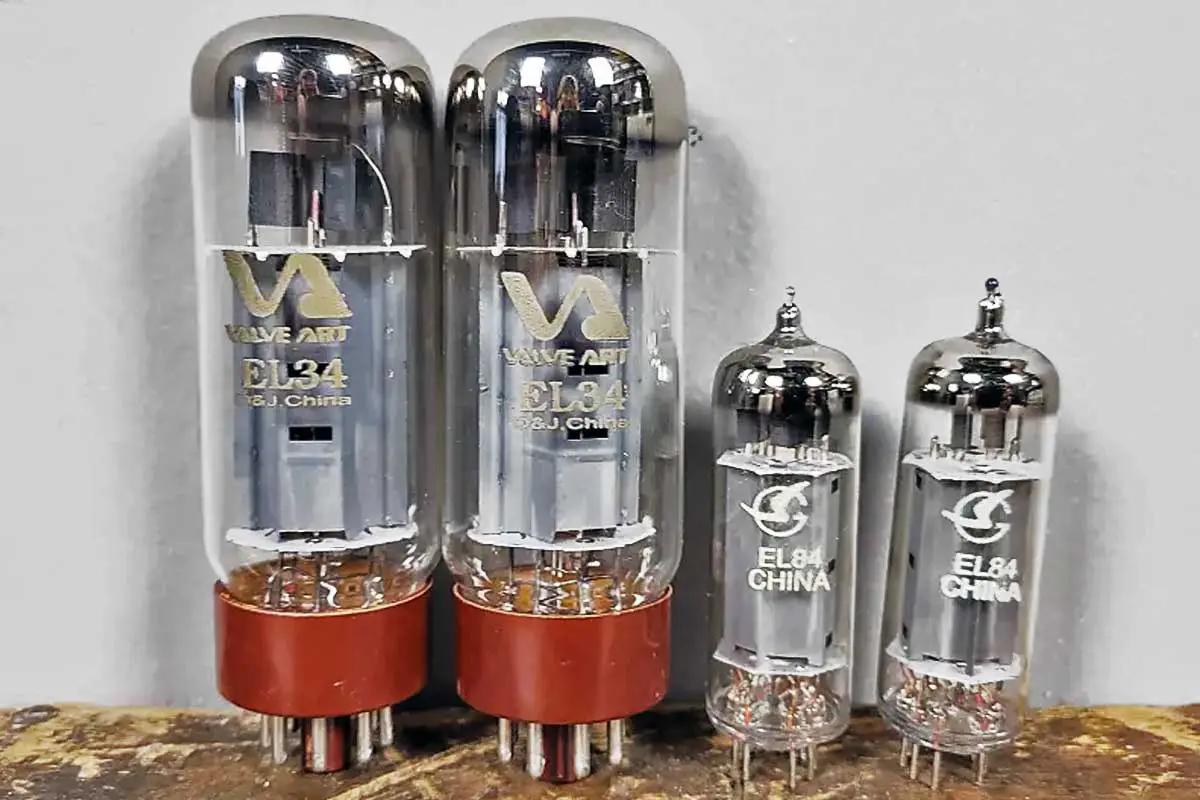When delving into the heart of guitar tone, you’ll encounter a debate among enthusiasts and professionals alike about the impact of vacuum tubes on an amplifier’s sound. Specifically, the discussion often centers around two prominent types of power tubes: EL34 vs EL84. These tubes are the lifeblood of many iconic amplifiers and are crucial in shaping the sonic character that ultimately pours out of your speakers.
Understanding the differences between EL34 and EL84 tubes is essential if you want to tailor your guitar sound to your precise preferences. The EL34 is known for its bold, assertive midrange and has been a staple in many British amplifiers, lending itself to the classic rock sounds of the 60s and 70s. In contrast, the EL84 is often associated with a chiming top-end and tight low frequencies, featuring heavily in British and American amplifiers favored for their articulate and responsive clean tones.
This comparison is not just about the technicalities; it’s about the very essence of your musical expression. The choice between EL34 and EL84 tubes will influence everything from the harmonics and dynamics to the touch sensitivity of your amp. Whether you’re chasing a specific genre’s tone or crafting your own signature sound, knowing these tubes and their distinct sonic footprints will be instrumental in your journey.

Understanding Vacuum Tubes and Their Role in Guitar Amplifiers
Your understanding of how vacuum tubes shape the sound of your guitar amplifier is crucial. The type of tube you choose, EL34 or EL84, affects the tone and performance of your amp.
Tube Basics: EL34 and EL84 Characteristics
EL34 Tubes: Renowned for their smooth midrange and rich bass, EL34 tubes are power tubes commonly found in high-end guitar amps. They typically exhibit higher headroom, making them ideal for genres that require distinct sound clarity, like rock or metal.
EL84 Tubes: On the other hand, EL84 tubes are known for their crisp, articulate top-end and tight response. These tubes are power tubes as well but often provide a more saturated overdrive at lower volumes, perfect for the classic British rock sound.
- EL34 Tubes:
- Higher headroom
- Smooth midrange
- Rich bass response
- EL84 Tubes:
- Crisp high end
- Tight, articulate response
- Saturated overdrive at lower volumes
The Influence of Vacuum Tubes on Amplifier Performance
Vacuum tubes, or simply tubes, are the core of a tube amplifier’s character and are divided into preamp tubes, power tubes, and rectifier tubes. The EL34 and EL84 tubes are types of power tubes that greatly influence your amplifier’s performance. An EL34 tube will typically provide a wider dynamic range and more defined distortion. On the other hand, EL84 tubes decrease headroom for an earlier breakup, contributing to a grittier tone. Your choice between the two will dictate the overall sound your amplifier will produce.
- EL34 Tube:
- Wider dynamic range
- Defined distortion
- EL84 Tube:
- Earlier breakup
- Grittier tone
Tube Amplification: From Voltage to Sound
The process where tubes transform the guitar signal into an audible sound is known as tube amplification. It begins as your guitar pickups send a small voltage to the preamp tubes. From there, that voltage is boosted by the power tubes which, depending on whether they’re EL34 or EL84 tubes, will color your sound differently. The EL34 delivers a broader sonic spectrum suitable for heavy music where the amplifier needs to provide a wall of sound. In contrast, the EL84 offers a more aggressive midrange punch, loved in genres where the guitar cuts through the mix distinctly.
- EL34 Tube Amplification:
- Broad sonic spectrum
- Suitable for heavy music
- EL84 Tube Amplification:
- Aggressive midrange punch
- Distinctly cuts through the mix
The cathode in these vacuum tubes is heated to release electrons, and as you play your guitar, the current modulates to create sound waves. It is essential to make an informed decision when choosing the tubes for your guitar amp, as this will impact the amplification and final sound.
EL34 vs EL84: Tonal Differences and Applications
When crafting your guitar tone, the choice between EL34 and EL84 tubes is pivotal. Each brings distinctive tonal qualities and wattage considerations to your amplifier, shaping the core of your sound.
EL34: Power and Headroom
With the EL34 tubes, you’re tapping into robust power and substantial headroom, suitable for achieving clear, undistorted tones at higher volumes. These tubes yield a pronounced midrange and a smooth distortion that’s central to the classic British rock sound. Due to their higher wattage output, EL34 tubes are frequently found in larger amps where maintaining a clean sound at elevated volumes is essential, making them a staple for genres like classic rock and jazz.
EL84: Clarity and Overdrive
In contrast, the EL84 tubes are celebrated for their crisp clarity and rich harmonic overdrive even at lower volume levels. Their lower power output translates to a sweeter saturation when pushed, encapsulating the quintessential chime that’s often associated with British amplifiers. Ideal for styles that benefit from a more intricate and articulate tonal palette, the EL84 tubes are versatile for genres ranging from rock to more distortion-heavy metal.
Choosing Between EL34 and EL84 for Your Style
Your musical style is key to deciding between these two tubes. If you prioritize a thick, gain-laden tone with plenty of headroom for a cleaner mix, the EL34 is your likely choice. Conversely, if your preference leans towards a tonally rich distortion at a manageable volume, which is excellent for home or studio practice, the EL84 might be the perfect match. Always consider the tonal characteristics you desire and the wattage requirements of your venues when choosing between these tubes for your amplifier.
Technical Specifications and Amp Design
When comparing the EL34 and EL84 tubes, it’s essential to consider how they differ in terms of technical specifications and amplifier design. These distinctions can greatly affect your amp’s performance and the resulting tone.

Power Handling and Amplifier Wattage
The EL34 tube is capable of higher power handling, with amplifiers typically producing between 25 and 50 watts. In contrast, the EL84 is generally found in lower wattage amplifiers, often in the range of 15 to 30 watts. This difference means that EL34-equipped amps can deliver more headroom and volume before distorting, making them suitable for larger venues.
- EL34 Tube Amps: 25 – 50 watts
- EL84 Tube Amps: 15 – 30 watts
Circuit Design: Biasing and Amplifier Classes
In terms of circuit design, the EL34 is frequently used in amplifiers with a fixed bias configuration, allowing for more precise control of the tube’s operation. On the other hand, EL84 amps often employ cathode bias which can yield a warmer sound and easier maintenance. Additionally, while both tubes can be utilized in Class AB amp configurations, the resultant tonal characteristics and efficiencies will vary due to their inherent electrical properties.
- EL34 Tube: Fixed bias preferred
- EL84 Tube: Commonly cathode biased
Related: On Biasing Guitar Amp Tubes
Matching Tubes with Speakers and Guitar Signal
Selecting the right tube involves considering the interaction with speakers and the guitar signal. EL34 tubes generally pair well with speakers designed for higher wattages and can accentuate mid-range frequencies. EL84 tubes, conversely, can give a chimey, brighter tone, often desired in smaller combo amps or recording setups. You must ensure that speaker wattage ratings match or exceed your amplifier’s output to preserve clarity and avoid damage.
- EL34 Tube: Matches with higher wattage speakers, mid-focused
- EL84 Tube: Suits lower wattage speakers, bright and chimey tone
Noteworthy Amplifiers and Tubes
When you’re exploring the relationship between guitar amplifiers and their tubes, understanding the impact of EL34 and EL84 values is pivotal. These tubes shape the voice of the amplifier, influencing everything from harmonic content to dynamic response.
Iconic Tube Amps and Their Signature Sounds
The Marshall Plexi, powered by EL34 tubes, has a robust and aggressive sound, making it a staple for rock guitarists. Conversely, the VOX AC30 is outfitted with EL84 tubes, known for their chimey, jangly top end, loved in genres from pop to classic rock. The Fender Twin Reverb, equipped with 6L6 power tubes, offers crystal-clear cleans, while the JCM 800 delivers the distinctive Marshall roar thanks to its EL34s, shaping the sound of ’80s hard rock.
Modern Choices: Balancing Quality and Affordability
Nowadays, finding an amplifier that melds quality and affordability is less of a wild goose chase. The Fender Blues Jr. stands out with EL84 tubes for those crisp, Fender cleans at reasonable price points. Additionally, the EVH 5150 series, with its 6L6 tubes, offers high-gain aficionados accessible, professional-level tone sculpting capabilities.
The Significance of NOS and Reissue Tubes
NOS, or New Old Stock tubes like Mullard and KT66, carry prestige for their vintage authenticity and sought-after tonal qualities, albeit often at higher prices. Reissue tubes, often found in modern amp models such as the VOX AC15 and Marshall JCM 800, provide you with reliable and consistent performance with the added benefit of being more budget-friendly. Preamp tubes like the 12AX7 influence your amp’s tonal clarity and gain structure, playing an integral part in the overall sonic signature.
Valve Amplifier Tube Comparisons
Want to learn more about guitar amp tubes? Explore the nuanced distinctions between preamp and power tubes, including popular matchups like ECC83 vs 12AX7 and EL34 vs KT88, as we unravel the sonic differences that shape your guitar’s unique voice.
| Tube Types | Application |
|---|---|
| ECC83 vs 12AX7 | Preamp Tubes |
| 12AU7 vs 12AX7 | Preamp Tubes |
| 6L6 vs EL34 | Power Tubes |
| 6L6 vs KT66 | Power Tubes |
| 6L6 vs 6V6 | Power Tubes |
| 5881 vs 6L6 | Power Tubes |
| EL34 vs EL84 | Power Tubes |
| EL34 vs KT88 | Power Tubes |
| EL34 vs KT77 | Power Tubes |
| EL34 vs KT66 | Power Tubes |
| 6V6 vs EL84 | Power Tubes |
